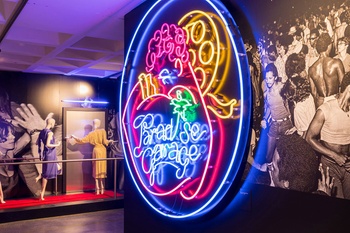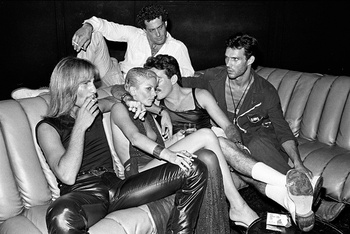One might debate the good taste of all those hedonistic temples of dance, but the fact that they prefigure numerous social trends is undeniable. An exhibition at ADAM is linking club culture to design.
Dance floor at Xenon, New York, 1978
It is almost unbelievable that nobody has previously come up with the idea of organizing an exhibition about one of the most remarkable phenomena of the past half century: that people – especially in the Western world – began to develop a predilection to wriggle their way between kindred spirits, preferably in enclosed locations where the music was loud and there was very little space to move. The Vitra Design Museum in Weil am Rhein decided to redress this historical lacuna and found that ADAM, the Brussels Design Museum, was a willing partner to present this exhibition with international appeal outside Germany.
More than thirty nightclubs, some more iconic than others, are featured in “Night Fever. Designing Club Culture 1960 – today”. They are located (or in most cases, were located) primarily in Italy, which played a pioneering role in design, and in the metropolises New York, London, and Berlin, as a number of city maps near the entrance of the show make clear.
The fact that nightclubs cannot last forever is evident from the trends and the zeitgeist upon which they seek to capitalize. In a museum context, this is a benefit. Especially in an age in which a ticket is a barcode on your smartphone, you would become nostalgic from seeing manually designed tickets – puzzle pieces signed by Keith Haring, or a hollowed-out egg that you had to break before you could get in.

Exhibition view at ADAM
In the exhibition, which features a lot of photos, posters, and flyers, it is clear that going out in a social media-free world was to be experienced to the fullest. Because very little footage has survived from the early years of clubbing, there is a piece of wooden dance floor from the Haçienda in Manchester, also known as the Halluçienda, and there are mannequins with colourful designs by Walter Van Beirendonck. You enter the exhibition through the blitz doors of Mach 2, an infamous underground club in Florence. The avant-garde found a release in nightlife for all their radical designs for which the light of day was not ready.
Destination Moon
Inspired by the legendary Studio 54, pop, VIP, and celebrity culture gradually emerged. The parties became more grotesque and clubs changed into environments. The Palladium brought in the Japanese architect Arata Isozaki, while the Area, another New York club, changed its look every six weeks. A series of photos shows how during a “War”-themed evening, clubbers could still parade with fake machineguns, and how during a science fiction night, Tintin flew a spaceship.

Studio 54, New York
That is not the only link with Belgium. The mixtapes that co-curator Katarina Serulus found in the house of Jean-Claude Maury’s widow are given a prominent place because the Murano DJ was the godfather of the Balearic beat. Horst resurrects as a scale model because their Arts & Music Festival was a perfect example of how to blend music and art, architecture, and design to create a Gesamtkunstwerk.
The Mothership, which landed in Detroit in 2015, demonstrates that clubs are not only the catalysts of trends. The portable DJ station elevates club archaeology to new heights. Named after one of George Clinton’s stage props and designed by a local studio, it breathes new life into both musical heritage and run-down neighbourhoods. Being seen and creating community can be combined perfectly.
A downside of “Night Fever” is that you can only dance to pre-disco, disco, techno, and house (in the installation by Konstantin Grcic), but a Brussels Club Map invites all the visitors to discover all the local hotspots themselves. Head into the night!
> Night Fever. Designing Club Culture 1960-Today. > 5/5, ADAM – Brussels Design Museum
Read more about: Expo
Fijn dat je wil reageren. Wie reageert, gaat akkoord met onze huisregels. Hoe reageren via Disqus? Een woordje uitleg.